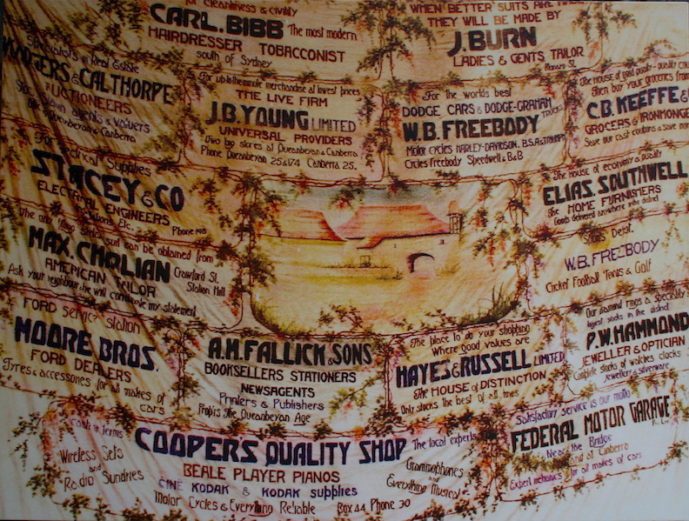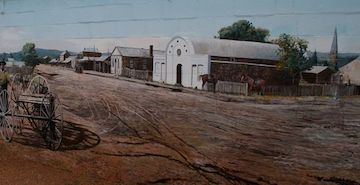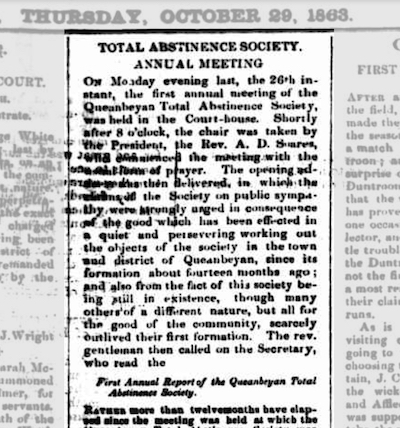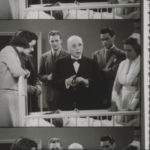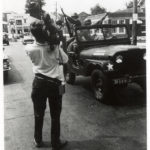A Curtain Tells of a Town’s Cinema History
By Peter Monaghan
An almost 100-year-old canvas cinema curtain in Queanbeyan, a southeastern Australian town, bears telling witness to the life of the settlement, and to the early history of film exhibition in the region and the whole country.
It’s held in the Queanbeyan Museum, which occupies a modest, disused police sergeant’s residence that was built in 1876 on the road through town, next to the police station.
The Museum is not nearly big enough for curators to roll the large theater curtain out for view. They have unfurled it only three times since its donation in the 1980s. That came from Charlie Hawes, a former projectionist at the Triumph cinema where it had hung.
The Queanbeyan Museum’s curators count the curtain as one of their most cherished items, in good part for the tale it tells of Queanbeyan life in the 1920s. The drape doubled as a sort of advertising hoarding. On it are hand painted insignia and pitches from just about every business and service in the center of town at that time. Several such panels surround an image of a European country house framed with northern vegetation. That’s rather incongruous given that Queanbeyan is on the other side of the world and is vegetated by sere, gnarled eucalyptus trees commonly decked with shrieking cockatoos.
“You can track which people ran businesses, then,” says one of the museum’s honorary curators, Gillian Kelly. Each advertising panel cites not only the business and its name, but also the name of its proprietor. “Theo. Cooper — he was a bit of a character in the theater world,” says Kelly. “He’s there with his ads for radios. He got involved in electronics very early on in the piece.”
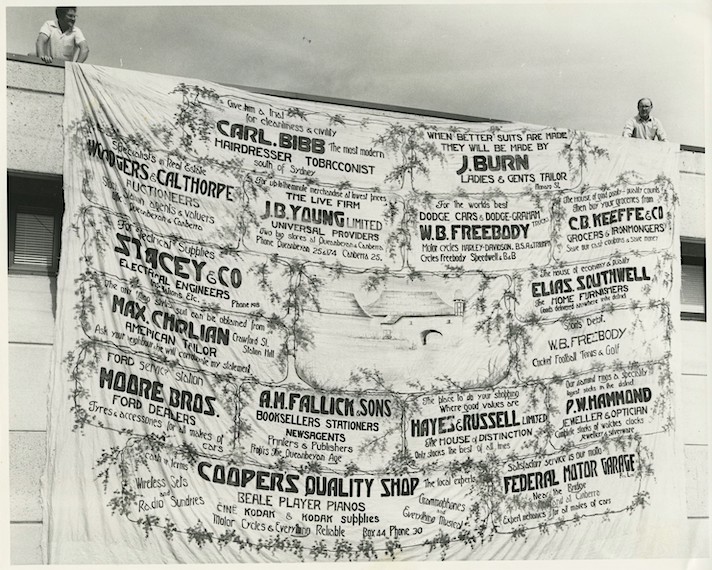
A photograph of the Triumph Theatre curtain, commissioned by the Queanbeyan & District Historic Museum Society, the owners of the curtain, for research and recording purposes as the curtain itself is too large for display.
The curtain is, then, a modest but significant artifact. It hung at the Triumph Hall picture theater, which was open from 1913 to 1964. But the region’s history of film exhibition dates back much further. Building on the popularity of magic lantern shows, in 1897 Edison’s Cinematographie came to town. That first screening was at the Protestant Hall, a gathering place attached to the Anglican Church that later became the town’s Macedonian Orthodox Church of the Prophet Elijah, a monument to mid-20th century immigration from eastern and other parts of Europe.
The 1897 screening was a remarkable event given that film had been shown commercially, anywhere, for less than two years. At the end of 1895, in Paris, 10 short films by the Lumière brothers screened publicly. Australia’s first public screenings took place in October 1896, in Sydney, less than a year later.
Queanbeyan was a small town some 200 miles from Sydney, and far from any other city or town of any size, and it was well and truly off the beaten track, as likely to be visited by outlaw “bushrangers” as by new settlers or even sightseers.
The speed of film’s arrival in the town demonstrates just how fascinating the emerging medium was to anyone who was exposed to it.
At that time, Queanbeyan was, in reality, a dusty cow town on the banks of a river of the same name, derived from a local Aboriginal word meaning “clear water,” or that’s historians’ best understanding today. While its population then was tiny — only the farms of the surrounding district explained its ability to construct various civic buildings — it had existed for a while, by the standards of Australia’s European settlement. It had been proclaimed a township in 1838 when only 50 people lived there. In 1836 it got a post office, in 1837 its first resident police magistrate. Its first newspaper began publishing in 1860. The railway reached the town in 1887.
Queanbeyan is now just a few miles from Australia’s national capital, Canberra, but the so-called “bush capital” was not even tentatively begun until just before World War I, and little took shape there before 1927.
In oral histories taken a good while ago, some townsfolk contended that some of the traveling movie shows took place at the Temperance Hall. It was built in 1896 to advance the Temperance Society’s campaign against grog, that “fruitful source of care, misery, drunkenness, and immodesty.” That the hall, now hidden behind the facade of an abandoned real estate agent’s shopfront, would host sinful films seems a bit unlikely, whatever the old timers said.
 Temperance Hall was the stronghold of early settlers who had opted to shun the bottle. They had established the Total Abstinence Society in 1862, with a less severe name from 1871: Sons and Daughters of Temperance. Temperance Hall, seating 500 people — a whole lot of abstinence! — opened in 1878 and that was a big deal at the time. The society’s members set about promoting sobriety by such means as discouraging shopkeepers’ practice of thanking customers with an alcoholic drink.
Temperance Hall was the stronghold of early settlers who had opted to shun the bottle. They had established the Total Abstinence Society in 1862, with a less severe name from 1871: Sons and Daughters of Temperance. Temperance Hall, seating 500 people — a whole lot of abstinence! — opened in 1878 and that was a big deal at the time. The society’s members set about promoting sobriety by such means as discouraging shopkeepers’ practice of thanking customers with an alcoholic drink.
The abstinent urged even moderate drinkers to embrace sobriety as a way of “showing a good example to drunkards,” as The Golden Age newspaper (now the Queanbeyan Age) put it in 1863, reporting on the group’s first annual meeting.
The society claimed that pledging abstinence was, for members, “a safeguard to themselves from being led by slow degrees into the degrading vice which has overspread the land with misery and crime,” for “it is an indisputable fact that every drunkard was a moderate drinker at first.”
Meanwhile the town was growing and more entertainment was needed than pubs and pride in sheep and cattle. By that time, the now heritage-listed showground had been in use for 50 years or more, to tout the region’s agricultural accomplishments. The facility’s siting had impinged on a traditional gathering and burial site for Aboriginal people of the region.
Soon traveling showmen were bringing movie shows to various halls in the town, such as the World Wide wonder show of 1907, where a traveling theater man named Dan Barrie projected short film clips to the town’s no doubt wonderstruck assortment of farmers, traders, and their families.
The Queanbeyan Museum’s Gillian Kelly muses: “It wasn’t so much what had been filmed; it was the fact that it was filmed with movement that you could see. That’s what entranced people, not the actual story.”
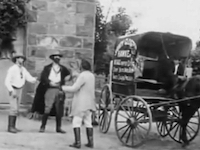 In 1910, narrative did matter. That was the year a Mr. W. Anderson brought The Story of the Kelly Gang to town (again at the Anglican hall) while touring it around the state of New South Wales. Made in 1906, it was the first feature film shown in the town. The 70-minute drama depicted the misadventures of Australia’s most notorious bushranger, Ned Kelly, who even today is celebrated — no doubt too generously — as some sort of mildly wild colonial boy.
In 1910, narrative did matter. That was the year a Mr. W. Anderson brought The Story of the Kelly Gang to town (again at the Anglican hall) while touring it around the state of New South Wales. Made in 1906, it was the first feature film shown in the town. The 70-minute drama depicted the misadventures of Australia’s most notorious bushranger, Ned Kelly, who even today is celebrated — no doubt too generously — as some sort of mildly wild colonial boy.
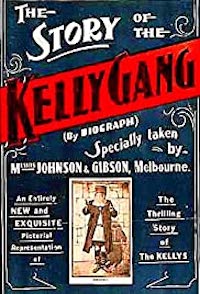 Says Gillian Kelly (no relation): “The Queanbeyan Age wrote it up as being an horrendous presentation, maybe because it glorified the Kelly boys a little bit, I think. It was nothing to do with the film.”
Says Gillian Kelly (no relation): “The Queanbeyan Age wrote it up as being an horrendous presentation, maybe because it glorified the Kelly boys a little bit, I think. It was nothing to do with the film.”
Like its hero, the film came to grief. Only 17 minutes of it remain. In 2007, UNESCO included those on its Memory of the World Register as the first full-length narrative feature film, anywhere.
The next year, 1911, proved a big one for film in Queanbeyan. An entrepreneur, JD Williams, screened a film of the Johnson vs Jeffries championship fight at the Protestant Hall, and admission jumped from 1 shilling and 6 pence — 1/6, or “one and six” — to 4 shillings, 3 shillings, and 2 shillings, with a seat. After that, for standing room, who knows?
Also on the bill, “Light film, for the ladies.”
Some asides, about that Johnson film: It depicted a world heavyweight championship bout, billed rather fancifully as “The Fight of the Century,” staged in Reno, Nevada, in July 1910. There, reigning champion Jack Johnson, a black American, thoroughly outboxed and in the 15th round knocked out former champion James J. Jeffries, one of boxing’s succession of “Great White Hopes.”
The fight’s promoter, George “Tex” Rickard, who had even refereed the walloping, held rights to the film, shot by nine cameramen. The racialized hype around the contest provoked such controversy, and riots around the country, that Congress banned distribution across state lines of prizefight films from 1912 to 1940. (In 2005, the United States National Film Registry inducted the Johnson/Jeffries film into its collection of essential American films worthy of permanent preservation.)
Also in 1911, another Sydney film company, the Victor Film Company, started coming to the town to exhibit films in the same hall, Friday and Saturday nights.
That expanded the town’s social calendar, which had most prominently featured dances in various halls. Those would remain popular well into the era of being encouraged to stay at home to watch television.
Then in 1912, “along came Theo Cooper and a fellow called Vic Lyneham,” says Kelly. “And they started to show films on Wednesday nights.” They opened their Swastika Picture Company very near the middle of town, “before Hitler ruined the image of what the swastika really was,” as Kelly puts it. “And they ran colored electric lights from the main street, up Crawford Street, to the theater, to show people how to get there, and they were pretty successful.”
A sign near Jordan’s Joinery pointed to “Pictures,” where today a discount gift and knickknack shop occupies the site, with hardly the same magic. Once moviegoers arrived at the Swastika, they learned that it was “the pleasure seekers’ popular resort with best management, best seating accommodation, expert operator, and talented musician.” Cooper and Lyneham set their admission prices at 1/- (one shilling) and 6d (sixpence) — expensive but not exorbitant — with kids half price.
The Swastika operated with the latest fancy equipment, but that did not deter another entrepreneur, William Freebody, from opening an open-air theater very nearby, on a paddock beside the home of the Hawes family — the same Hawes family whose projectionist descendant would later donate the Triumph cinema curtain to the Queanbeyan Museum.
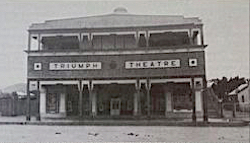
The Triumph, back in the day. Image: Bygone Queanbeyan, Queanbeyan-Palerang Libraries & Queanbeyan City of Champions.
Freebody’s Triumph Picture Hall and Skating Rink was a semi-open air affair with a canvas roof over a wooden platform. At night it showed movies (screened from a tin shed beside the house), and during the day the platform served as a roller-skating rink. “That was how Freebody made his money for quite a long time,” says Kelly.
Like the Swastika’s Cooper and Lyneham, the Triumph’s Freebody was in no doubt that running a theater efficiently was a selling point. The Triumph boasted its technological capabilities by trumpeting its “truly perfect pictures.” Freebody advertised that the Triumph had “the best management, the best seating, the best accommodations, an expert operator, and a talented musician.” The last of those meant, as Kelly notes, “a talented musician who could jump and change to what’s going on on the screen. That was very important.”
The town’s agricultural base came to be augmented by light construction, manufacturing, services, and retail, most of it undertaken by British, Irish, and then European immigrants. Newcomers brought more demanding tastes. In 1922 tenders were called to update The Triumph with a gallery, balcony, stage, and supper rooms.
Sooner after that, in 1925, the operators of the Triumph also hit on the idea of having a striking theater curtain that they hauled up and down by hand. Its heavy canvas served both to protect their screen from roller-skating dust and to advertise local businesses.
As late as 1927, Canberra was still in its birth pangs as the capital city of Australia. It was created because Melbourne and Sydney — the largest cities, then and now — could not cease their squabbling over which should be the capital. Queanbeyan just kept on doing what it was doing, as it continues to do now with its 57,000 people, a stone’s throw from Canberra’s 400,000.
The burgeoning capital’s governmental founders were “wowsers” who severely limited its number of alcoholic watering holes, so Queanbeyan remained a draw. It entertained the builders who were constructing the capital, and their families. In many cases those early residents were living in canvas tents for lack of more solid dwellings.
So, entrepreneurs like W. Anderson could count on bigger movie crowds than those of an average small country town. Queanbeyan was not on the primitive highway that linked Melbourne and Sydney, nor any road directly to the coast, 100 miles east. Even its few near-neighbor towns weren’t near.
Even as World War II slowed Canberra’s development, Queanbeyan remained the best place for viewing films. In 1925, after a fire raged in the middle of town, the Catholic Church bought land there and built the large, elegant St Gregory’s Hall. Inside it, early in 1925, Mr F.H. Boland, a noted press photographer, established a rival to the Triumph called Star Pictures.
“The very interesting thing about that theater,” says Kelly, “was that it was the first theater in the Southern Hemisphere to show a Metro Goldwyn film; in other words, the big feature films. And that’s not just here, that’s in the whole Southern Hemisphere.”
Almost obligatorily, it advertised its “civility, comfort, and attention.”
“I think that was maybe a reflection that the Triumph didn’t have those things,” chuckles Kelly. “Maybe the Triumph was a bit rough and rugged.”
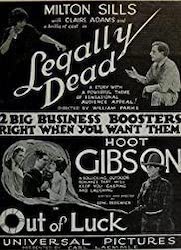
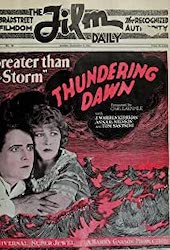 Residents of Canberra, the nascent national capital, came by whatever means available — buggy, bus, or their own two feet, to watch films. Those generally had been made in the United States and Britain — films like Thundering Dawn and Legally Dead, along with newsreels. Prices were 1/6 and 1/- plus tax.
Residents of Canberra, the nascent national capital, came by whatever means available — buggy, bus, or their own two feet, to watch films. Those generally had been made in the United States and Britain — films like Thundering Dawn and Legally Dead, along with newsreels. Prices were 1/6 and 1/- plus tax.
Freebody, eager to keep the Triumph competitive with the Star, advertised the Triumph’s “good engine, good operator, good music, and good management.” Then, in 1927, he resolved the battle for which theater had the better management and decorum by buying The Star and running films at the two nearby theaters on alternate nights.
Still, the introduction of talking movies at The Star threatened the survival of The Triumph. It closed for a while but in 1930 Freebody demolished the original, weatherboard Triumph and built a solid brick building with blue velvet curtains and soft leather seats upstairs. And he reinstalled his striking theater curtain.
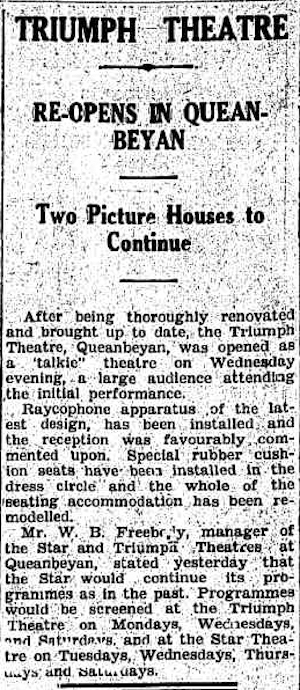 He celebrated the renovations by inviting the town’s senior citizens to a free screening of Over the Hill to the Poorhouse where the elderly hopefully could breathe sighs of relief that the events of the film did not reflect their own fates: it depicted a woman, Ma Benton, whose children grow up and snub her, forcing her into destitution.
He celebrated the renovations by inviting the town’s senior citizens to a free screening of Over the Hill to the Poorhouse where the elderly hopefully could breathe sighs of relief that the events of the film did not reflect their own fates: it depicted a woman, Ma Benton, whose children grow up and snub her, forcing her into destitution.
The film was made at least three times, first in 1908. In Harry Millarde’s 1920 silent drama, a box-office smash, Ma Benton (played by Mary Carr) joined by several of her own, real-life children, played a mother overwhelmed by her own fecundity. But presumably Freebody treated his townsfolk to the 1931 remake by Henry King starring Mae Marsh in her first talkie. (The US Library of Congress has preserved the film as part of its Silent Film Project of 2019.)
The Triumph came back to life throughout the 1930s and 1940s. The last major refurbishment occurred in 1957 with the purchase of a 28 foot screen for the new, emerging Cinemascope films. The dress circle and lounge was appointed with leather seats, while the downstairs stalls were reupholstered. A new green velvet curtain provided the finishing touch, which is presumably when the older, canvas curtain was mothballed.
The first screening was The Ambassador’s Daughter on 4 April 1957.
Despite a new “milk bar” (café), oil heating, and air conditioning, the Triumph staggered. Queanbeyan could no longer support two picture theaters. The Triumph closed in 1964. The building was sold and demolished in 1967. The Star stayed open for a while longer, and then another cinema opened and closed, but the town has been without a dedicated cinema for decades, now, despite frequent fruitless talk of building a new multiplex.
The Triumph’s old curtain remains, with a few holes but otherwise intact.
It, and the scripts and phrasing on it, hark to another, more cinema-friendly time: the advertisers included Woodgers & Calthorpe Auctioneers, specialists in real estate and stock & station agents and valuers for the farms of the region; JB Young Limited, “Universal Providers” who would become a major regional department store, then be taken offer by an even larger conglomerate; and Max Cholian, American Tailor, who was so assured of his suits’ superiority that he could bid any view to “ask your neighbour — he will corroborate my statement.”
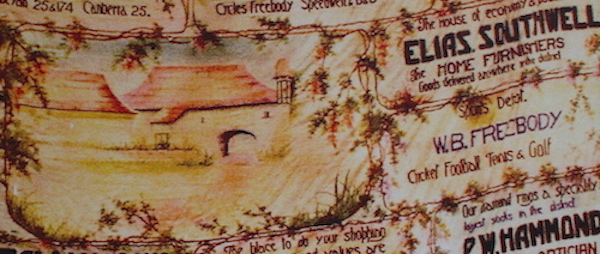 The proprietors of Cooper’s Quality Shop were “the local experts” in “grammophones [sic] and Everything Musical” including wireless sets and “radio sundries,” camera supplies, and also motor cycles “& Everything Reliable.” The Cooper’s telephone number was simply “30.” C.B. Keeffee & Co. were grocers and ironmongers, both. W.B. Freebody sold motor cycles, as well as sports gear for cricket, football, golf, and “tenis” — the curtain needed better proofreading.
The proprietors of Cooper’s Quality Shop were “the local experts” in “grammophones [sic] and Everything Musical” including wireless sets and “radio sundries,” camera supplies, and also motor cycles “& Everything Reliable.” The Cooper’s telephone number was simply “30.” C.B. Keeffee & Co. were grocers and ironmongers, both. W.B. Freebody sold motor cycles, as well as sports gear for cricket, football, golf, and “tenis” — the curtain needed better proofreading.
Federal Motor Garage, “Near the Bridge,” had “mehanics” for all makes of cars, but they, too, suffered at the paintbrush of the curtain’s graphic artist, too. “Satisfactory service is our motto” was the rather modest claim.
By contrast, Carl Bibb pulled no punches, declaring himself “the most modern hairdresser tobacconist south of Sydney.
Doubt it? “Give him a trial for cleanliness & civility.”
Such pitches across the curtain’s expanse surround that odd European chateau, which looks like a formatted centerpiece. “It makes me think it was more or less a template,” Kelly surmises. The curtain’s manufacturer in Sydney — its name and history so far undiscovered — may well have made such curtains for other cinemas around the country, to serve as both advertising hoardings for businesses and protective screens — something the Triumph, as a dusty daytime skating rink, certainly would have needed.
Today the curtain, almost eight yards wide and more than five from top to bottom, has a few holes, but is otherwise in good condition. Inside the Queanbeyan Museum, you can see that in a one-fifth-scale photo, which is the best viewing the Queanbeyan Museum can provide, given its space limitations. Curators list the curtain as one of 45 prized items in the Museum’s collection.
Today’s version of the cinema advertising curtain — pre-attraction mini-features that are large, loud, and oh so slick — have nothing on it.
 By the way, the street where the Triumph was so long triumphant, Crawford Street, has in recent years become the site of some efforts to spruce up the town by highlighting some of its surprising history.
By the way, the street where the Triumph was so long triumphant, Crawford Street, has in recent years become the site of some efforts to spruce up the town by highlighting some of its surprising history. 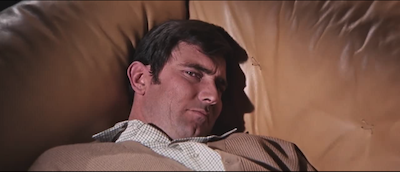 Along it is the Queanbeyan Honour Walk 2017 where pavement plaques commemorate significant figures from the town – public figures, sports stars, even one movie star, the reluctant James Bond, George Lazenby.
Along it is the Queanbeyan Honour Walk 2017 where pavement plaques commemorate significant figures from the town – public figures, sports stars, even one movie star, the reluctant James Bond, George Lazenby.
“The different James Bond” starred in On Her Majesty’s Secret Service (1969) but when asked to take the Bond role in two more of the 007 spy thrillers, passed up on the opportunity.
Previous Post: Looking Again at Eyes on the Prize
Next Post: How Will an Important Archive Ever Recover?

